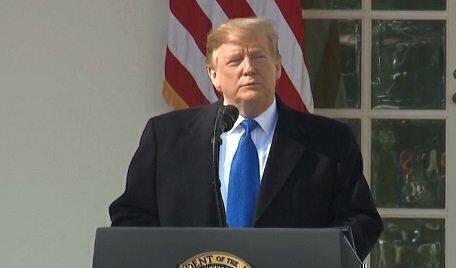President Donald Trump has threatened to veto any measure passed by Congress that blocks his national emergency declaration to build a border wall. What exactly is the veto power, what are its limits and is Trump unusual for his lack of vetoes in the past two years?
 The House passed a resolution of disapproval on the border wall emergency by a 245-182 vote on February 26, 2019, citing its powers under the National Emergencies Act. “Any national emergency declared by the President in accordance with this subchapter shall terminate if there is enacted into law a joint resolution terminating the emergency,” the law says.
The House passed a resolution of disapproval on the border wall emergency by a 245-182 vote on February 26, 2019, citing its powers under the National Emergencies Act. “Any national emergency declared by the President in accordance with this subchapter shall terminate if there is enacted into law a joint resolution terminating the emergency,” the law says.
The Senate has yet to vote on the resolution, but Majority Leader Mitch McConnell has said a vote will be held before the March 18th recess.
For the joint resolution to go into effect, it must be signed by the President or left unsigned for 10 days. Article 1, Section 7 of the Constitution gives the President the power to veto legislation or joint resolutions such as the one permitted under the National Emergencies Act, by notifying Congress of his objections.
“Every Order, Resolution, or Vote to which the Concurrence of the Senate and House of Representatives may be necessary (except on a question of Adjournment) shall be presented to the President of the United States; and before the Same shall take Effect, shall be approved by him, or being disapproved by him, shall be repassed by two thirds of the Senate and House of Representatives, according to the Rules and Limitations prescribed in the Case of a Bill,” the clause reads.
The veto occurs when a President objects to a bill or resolution. The President usually sends the bill back to Congress with a message explaining his objections; this is known as a direct veto. If the President withholds his signature during the 10-day review period allowed by the Constitution and Congress adjourns during that period, it is considered a “pocket veto” and the bill doesn’t become a law. The last pocket veto used by President Bill Clinton in December 2000.
Overriding a presidential veto requires a two-thirds majority in both the House and the Senate, as specified in Article 1, Section 7. Given the expected vote margin in the Senate, it is unlikely Congress will override the expected President Trump veto, so the veto will be sustained.
In either event, if Trump does issue a veto, it would be the first of his presidency. President Barack Obama only used the veto twice in his first two years, and Congress didn’t override either veto. During his eight years in the White House, Obama issued 12 vetoes and only one was overridden - a veto of the Justice Against Sponsors of Terrorism Act in September 2016.
His predecessor, President George W. Bush, didn’t use a single veto during his first term, but he issued 12 vetoes in his second term, and 11 of the vetoes came in 2007 and 2008 – when the Democrats controlled the Senate and the House. Just four of the 12 Bush vetoes were overridden.
Often, the threat of a veto is enough to ward off legislation that will surely get rejected by the President. This is known as “veto signaling.”
One official way the President can warn Congress about his intention to issue a veto is by using a Statement of Administration Policy, and President Trump did just that on February 19.
“This is the same authority that President George W. Bush and President Barack Obama used to undertake more than 18 different military construction projects between 2001 and 2013,” the Office of Management and Budget said in the statement. “If H.J. Res. 46 were presented to the President in its current form, his advisors would recommend that he veto it,” the statement concluded with the last sentence underlined.
The Obama and George W. Bush presidencies marked a noted shift in the use of vetoes as policy tactic or a sign of presidential disapproval. In terms of total vetoes (regular and pocket), they were the fewest vetoes issued by a President since Warren Harding was in office between 1921 and 1923. And for two-term Presidents, the Obama and Bush White Houses issued the fewest regular vetoes since the Andrew Jackson administration.
The king of presidential vetoes was Grover Cleveland, whose Democrats only controlled Congress for two of his eight years in office. President Cleveland issued 304 regular vetoes in eight years. Cleveland was also a big fan of the pocket veto; he issued 238 pocket vetoes. Franklin Roosevelt used the regular veto 372 times in 12 years.
The least-successful Presidents with vetoes were Andrew Johnson and Franklin Pierce. Johnson used 29 vetoes in four years, but 15 of his vetoes were overridden. Pierce saw five of his nine vetoes overridden by Congress.
Scott Bomboy is the editor in chief of the National Constitution Center.







